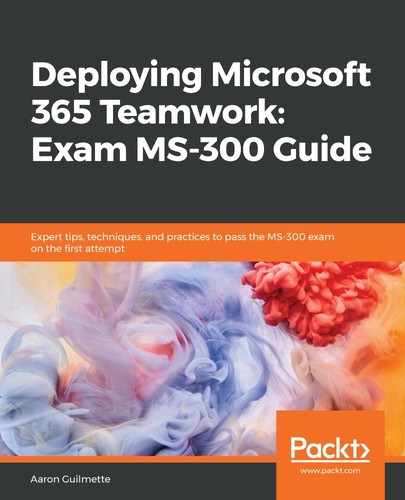Content Search is performed in Microsoft Teams by using the Security & Compliance center. The Security & Compliance center allows you to conduct content searches both within the boundary of an eDiscovery case as well as standalone.
As you have learned throughout this book, Microsoft Teams and the underlying Office 365 Groups on which Teams are based touch on multiple technologies, including Exchange mailboxes and SharePoint Sites. When performing searches for data located in Microsoft Teams, you can normally just select the Microsoft Teams object in the Security & Compliance center search interface. However, you may need to select Teams as well as individual user mailboxes and SharePoint sites, depending on the configuration of the team and what type of content you are searching for:
- Team private channels: Team private channels have separate SharePoint sites (not connected to the SharePoint site of the original team). Conversations in private channels are recorded in the respective mailboxes of all private channel members. When searching for content that may be present in private channels, you'll have to select both the private channel SharePoint URLs as well as the mailboxes of the private channel members.
- Guest chats: To index and store the chats of guests, the Office 365 service provisions a phantom or shadow mailbox for external recipients. Conversation content for guests is stored in those mailboxes.
Locating the associated private channels for a Team will take a bit of PowerShell scripting—you'll need both the Microsoft Teams and SharePoint Online PowerShell cmdlets.
In our example, we have created a Team called Project Rover and have created a private channel called Rover Private Channel, as shown here:

To locate the team members whose mailboxes we'll need to include in eDiscovery or content search as well as the URL of the private channel, we'll need to run several PowerShell commands. As mentioned earlier, you'll need both the Microsoft Teams PowerShell module and the SharePoint Online PowerShell module.
To install the Microsoft Teams PowerShell module, run Install-Module MicrosoftTeams from an elevated PowerShell prompt. To install the SharePoint Online Management Shell, download and install it from https://www.microsoft.com/en-us/download/details.aspx?id=35588.
Once you have those modules installed, you can run the following commands to connect to Microsoft Teams and SharePoint Online and search for the necessary SharePoint Online URLs and private channel members to add to an eDiscovery or content search. Use your own tenant name where "tenant" is present. Replace "Team Name" with the team name that you are trying to locate private channels for.
To connect to Microsoft Teams, use the following command from a PowerShell console:
Connect-MicrosoftTeams
To connect to SharePoint Online, use the following command from a PowerShell console:
Connect-SPOService -Url https://<tenant>-admin.sharepoint.com
